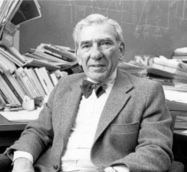Abstract
Copyright 2012 American Association for Aerosol Research

Melvin W. First, Sc.D., CIH, PE, died 13 June 2011 at the age of 96. Mel was a researcher and Professor of Environmental Health Engineering at the Harvard School of Public Health for almost 60 years and was actively involved in research until a week before his death. His students and colleagues will remember him as a man with firm opinions that were rooted in his commitment to protect public health through the application of sound engineering principles. Although Mel's work was a major focus of his life, his words and actions made it clear to everyone that the center of his world was his wife, Julia; she always came first.
Mel liked to say that becoming an engineer at MIT and then a biologist at Harvard was the usual path, but he did the opposite. He earned a degree in biology and public health at MIT in 1936, then worked as a toxicologist and an industrial hygiene engineer in Michigan until 1941 when he entered the armed services. After World War II, he enrolled at Harvard, where he earned a master's degree in sanitary engineering in 1947 and a Sc.D. in industrial hygiene engineering in 1950. The topic of his doctoral thesis was the performance of cyclones to control fine particles, and controlling airborne contaminants remained the focus of his career for the rest of his life.
After graduation, Mel was a private consultant until 1956 when he joined the Department of Industrial Hygiene at the Harvard School of Public Health, rising through the ranks to become Professor of Environmental Health Engineering in 1971. In keeping with his goal to use his knowledge to solve applied problems, he remained active as a consulting engineer throughout his career. Because Harvard had mandatory retirement at the age of 70, he became an emeritus professor in 1985 but continued to work daily on the Harvard faculty for the next 26 years.
Mel was a practical man who valued research for the solutions it provides to issues in the real world. As he began his career in the 1930s, he saw first-hand the safety and health problems of workers in Michigan. Not content simply to identify public health problems, Mel's life purpose was to solve them. Through the 1950s, 60s, and 70s, he studied how to control air pollutants at the source using devices such as cyclones, scrubbers, and filters. His work was usually related to problems in industry, often to nuclear power. Mel was chairman of the biennial Department of Energy/Nuclear Regulatory Commission Air Cleaning Conferences for three decades. In the 1980s and thereafter, his focus moved to the control of airborne infectious agents such as Mycobacterium tuberculosis in hospitals and homeless shelters.
Mel took teaching seriously. In addition to teaching a graduate course on community air pollution, he developed and taught perhaps the first graduate-level course on engineering methods to control air pollutants. He also developed the Harvard “In-Place Filter Testing Workshop” and helped teach other continuing education courses related to industrial hygiene and nuclear safety. In 2008, he co-founded a two-week course for engineers and architects on “Building Design and Engineering Approaches to Airborne Infection Control.” During the last years that he taught classes, he memorized his lectures because his failing eyesight made it too difficult for him to read his slides. In 2009, Mel decided to discontinue teaching, although he continued his daily involvement in research.
Because he believed deeply in the importance of protecting public health, Mel was never one to tolerate shoddiness in scholarship. If he disagreed with someone he would speak up, because he believed that doing so was his responsibility as a tenured, full professor. But those who shared his principles and who had earned his respect through the quality of their work could always count on his help and support.
The uncomplaining temperament, determination, and optimism that always characterized Mel became even more apparent near the end of his life. His eyes were failing, he walked with difficulty, and his hearing was poor, but he never complained about his ailments. This is not to say that he did not complain when others failed to meet his high standards. He used a device that greatly enlarged printed material and projected it onto a computer screen. He could see only a few words at a time and then had to move the text manually. Nonetheless, he continued to read and write technical papers. Even toward the end, he was willing to take on almost any research project and he was always confident that his projects would come out well.
Mel received many awards and honors, including the Lyman A. Ripperton Award from the Air Pollution Control Association and the Cummings Memorial Award from the American Industrial Hygiene Association. He served on important professional advisory boards and committees, including the Chemical Weapons Destruction and Disposal Advisory Committee of the US Army Command; the National Academy of Sciences Submarine Air Quality Committee; and as a consultant to the Advisory Committee on Reactor Safeguards of the U.S. Nuclear Regulatory Commission.
Mel First was one of a kind and will truly be missed. Those working with him at the time of his death knew that he could not go on forever, although sometimes it seemed that he could. He is survived by two sons, Bill and Mike First, and Mike's wife Kiar; grandchildren Josh, Travis, Andrea, and Matt; and six great-grandchildren. The family requests that any gifts in his honor go to “The Melvin W. First Fellowship Fund,” Attn: Kate Osterman, Harvard School of Public Health, 90 Smith Street, 4th Floor, Boston, MA 02120, USA. This fellowship fund, an endowment whose proceeds are used to support doctoral students in environmental health engineering, was founded about 15 years ago by two Harvard School of Public Health graduates with a large donation in honor of Mel's many contributions to the School and the field of environmental health engineering.